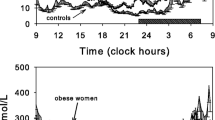Abstract
This review discusses the possible interrelationships between adrenal steroid hormones and the metabolic syndrome. Abnormal regulation of the hypothalamic-pituitary-adrenal axis has been proposed. Studies in the United Kingdom associated the metabolic syndrome with low birth weight and hyperactivity of the entire axis. In Italy, increased pituitary responsiveness to stimulation with vasopressin and corticotrophin-releasing hormone was demonstrated in women with central obesity. Swedish researchers have reported that increased stress responses of the axis correlated with a less variable but decreased cortisol level. An allele of the glucocorticoid receptor was also associated with various components of the metabolic syndrome. Evidence also suggests that central obesity is associated with an increased peripheral conversion of cortisol to cortisone and subsequent feedback stimulation of the axis. On the other hand, central fat may have an increased local metabolism in the direction of cortisol. Roles for dehydroepiandrosterone and aldosterone in the syndrome have also been proposed.
Similar content being viewed by others
References and Recommended Reading
Aron DC. Endocrine incidentalomas. Endocrinol Metab Clin North Am 2000, 29:1–229. An exhaustive review on incidentally discovered endocrine masses.
Landsberg L: Role of the sympathetic adrenal system in the pathogenesis of the insulin resistance syndrome. Ann N Y Acad Sci 1999, 892:84–90.
Andrews RC, Walker BR: Glucocorticoids and insulin resistance: old hormones, new targets. Clin Sci 1999, 96:513–523. A review of the metabolic effects of glucocorticoids and how they interact with insulin’ actions.
Phillips DI, Barker DJ, Fall CH, et al.: Elevated plasma cortisol concentrations: a link between low birth weight and the insulin resistance syndrome? J Clin Endocrinol Metab 1998, 83:757–760. This article details the association between low birth weight and subsequent features of the metabolic syndrome.
Phillips DI, Walker BR, Reynolds RM, et al.: Low birth weight predicts elevated plasma cortisol concentrations in adults from 3 populations. Hypertension 2000, 35:1301–1306.
Benediktsson R, Lindsay RS, Nobel J, et al.: Glucocorticoid exposure in utero: new model for adult hypertension. Lancet 1993, 341:339–341.
Walker BR, Phillips DI, Noon JP, et al.: Increased glucocorticoid activity in men with cardiovascular risk factors. Hypertension 1998, 31:891–895. This study demonstrated increased sensitivity to glucocorticoids in association with a hereditary predisposition to hypertension and increased resistance to insulin and higher blood glucose levels.
Pasquali R, Cantobelli S, Casimirri F, et al.: The hypothalamicpituitary-adrenal axis in obese women with different patterns of body fat distribution. J Clin Endocrinol Metab 1993, 77:341–346.
Vicennati V, Pasquali R: Abnormalities of the hypothalamicpituitary-adrenal axis in nondepressed women with abdominal obesity and relations with insulin resistance: evidence for a central and a peripheral alteration. J Clin Endocrinol Metab 2000, 85:4093–4098. Secretion of ACTH and cortisol increased more after pituitary stimulation in participants with increased abdominal fat distribution. In addition, urinary free cortisol was decreased in these women, suggesting increased cortisol clearance.
Pasquali R, Vicennati V, Calzoni F, et al.: Alpha2-adrenoceptor regulation of the hypothalamic-pituitary-adrenocrotical axis in obesity. Clin Endocrinol 2000, 52:413–421.
Rosmond R, Dallman MF, Bjorntorp P: Stress-related cortisol secretion in men: relationships with abdominal obesity and hemodynamic abnormalities. J Clin Endocrinol Metab 1998, 83:1853–1859. The authors describe two separate patterns of ACTH and cortisol secretion. One pattern of decreased variability and lower morning values was correlated with increased stress responses and markers of the metabolic syndrome.
Rosmond R, Chagnon YC, Holm G, et al.: A glucocorticoid receptor gene marker is associated with abdominal obesity, leptin, and dysregulation of the hypothalamic-pituitaryadrenal axis. Obes Res 2000, 8:211–218. This study suggests that an allele of the glucocorticoid receptor gene is associated with altered pituitary feedback and correlations with features of the metabolic syndrome.
Bujalska IJ, Kumar S, Stewart PM: Does central obesity reflect "Cushing’ disease of the omentum"? Lancet 1997, 349:1210–1213.
Livingstone DE, Jones GC, Jamiesone PM: Understanding the role of glucocorticoids in obesity: tissue-specific alterations of corticosterone metabolism in obese Zucker rats. Endocrinology 2000, 141:560–563.
Weaver JU, Taylor NF, Monson JP: Sexual dimorphism in 11-beta hydroxysteroid dehydrogenase activity and its relation to fat distribution and insulin sensitivity: a study in hypopituitary subjects. Clin Endocrinol 1998, 49:13–20.
Kerstens MN, Riemens SC, Sluiter WJ, et al.: Lack of relationship between 11 beta-hydroxysteroid dehydrogenase setpoint and insulin sensitivity in the basal state and after 24h of insulin infusion in healthy subjects and type 2 diabetic patients. Clin Endocrinol 2000, 52:403–411.
Kimuara M, Tanaka S, Yamada Y, et al.: Dehydroepiandrosterone decreases serum tumor necrosis factor-alpha and restores insulin sensitivity: independent effect from secondary weight reduction in genenetically obese Zucker fatty rats. Endocrinology 1998, 139:3249–3253. A study in obese rats that implicates DHEA as a possible therapeutic tool in affecting insulin sensitivity.
Suzuki M, Kananzawa A, Hasegawa M, et al.: A close association between insulin resistance and dehydroepiandrosterone sulfate in subjects with essential hypertension. Endocrine J 1999, 46:521–528.
Yamaguchi Y, Tanaka S, Yamakawa T, et al.: Reduced serum dehydroepiandrosterone levels in diabetic patients with hyperinsulinaemia. Clin Endocrinol 1998, 49:377–383.
Maccario M, Mazza M, Ramunni J, et al.: Relationships between dehydroepiandrosterone-sulphate and anthropometric, metabolic and hormonal variables in a large cohort of obese women. Clin Endocrinol 1999, 50:595–600.
Goodfriend TL, Kelley DE, Goodpaster BH, et al.: Visceral obesity and insulin resistance are associated with plasma aldosterone levels in women. Obes Res 1999, 7:355–362. A link between aldosterone levels and the metabolic syndrome is presented.
Goodfriend TL, Egan BM, Kelley DE: Plasma aldosterone, plasma lipoproteins, obesity and insulin resistance in humans. Prostaglandins Leukot Essent Fatty Acids 1999, 60:401–405
Author information
Authors and Affiliations
Rights and permissions
About this article
Cite this article
Golub, M.S. The adrenal and the metabolic syndrome. Current Science Inc 3, 117–120 (2001). https://doi.org/10.1007/s11906-001-0022-x
Issue Date:
DOI: https://doi.org/10.1007/s11906-001-0022-x




